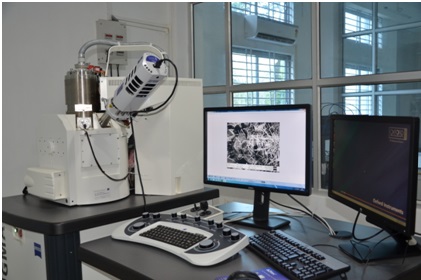





Sophisticated Analytical Instruments Facility
| Name of the equipment/facility: Emission Scanning Electron Microscopy (FESEM) |  |
|||||||||||||
| Make: Carl ZEISS Microscopy, Germany | ||||||||||||||
| Model: ZEISS, SIGMA | ||||||||||||||
| Specification: | ||||||||||||||
FESEM-IMAGE. EDX Elemental Mapping |
||||||||||||||
| Working Principle: | ||||||||||||||
The field emission scanning electron microscope (FE-SEM) images a samplesurface by raster scanning over it with a high-energy beam of electrons. The electrons
interact with the atoms comprising the sample to produce signals that contain informationabout surface topography, composition and other properties, such as electricalconductivity. There are two classes of emission source: thermionic emitter and fieldemitter. Emitter type is the main difference between the Scanning Electron Microscope(SEM) and the Field Emission Scanning Electron Microscope (FE-SEM).Thermionic Emitters use electrical current to heat up a filament; the two most commonmaterials used for filaments are Tungsten (W) and Lanthanum hexaboride (LaB6). Whenthe heat is enough to overcome the work function of the filament material, the electronscan escape from the material. Thermionic sources have relative low brightness,evaporation of cathode material and thermal drift during operation. Field Emission is oneway of generating electrons that avoids these problems. A Field Emission Source (FES);also called a cold cathode field emitter, does not heat the filament. The emission isreached by placing the filament in a huge electrical potential gradient. The FES is usuallya wire of Tungsten (W) fashioned into a sharp point. The FE source reasonably combines with scanning electron microscopes(SEMs) whose development has been supported by advances in secondary electrondetector technology. The acceleration voltage between cathode and anode is commonly inthe order of magnitude of 0.5 to 30 kV, and the apparatus requires an extreme vacuum(~10–6 Pa) in the column of the microscope.
|
||||||||||||||
| Applications: | ||||||||||||||
| Nano science/Nano Technology Thin Films Catalysis Polymer science Biological and life sciences |
||||||||||||||
| Contact | ||||||||||||||
| Division: Material Science and Technology Division. 1. Dr. L. Saikia, Scientist, lsaikia@neist.res.in, 9957031635 2. Dr. Jayaramudu Jarugala, Pr Scientist, jayaramj@neist.res.in, 8828481867 |
||||||||||||||
| Charges (Excluding Taxes) | ||||||||||||||
Charges (Excluding Taxes):
|
||||||||||||||